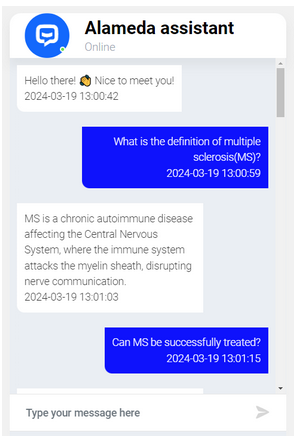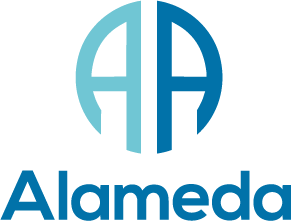In terms of the ALAMEDA Innovation Hub and AI toolkit, and more specifically in the context of T7.4 Third Party Digital Health Solutions leading, CERTH integrated its virtual agent as part of this community hub. The main prerequisite for this integration was to train the conversational agent, with proper educational content and formal guidelines collected by medical partners about the three chronic diseases such as PMSS (Parkinson’s disease, Multiple Sclerosis and Stroke). Prior to initiating the training process, a data augmentation technique is applied using the T5 text-to-text model to augment the Q/A pair dataset with paraphrased responses.
The main objective of the Health Educational Conversational Agent was the interaction with humans (health personnel and/or patients) in natural language text to provide medical guidance and advice to relevant stakeholders.
Integration with AI
In terms of the ALAMEDA Innovation Hub and AI toolkit, and more specifically in the context of T7.4 Third Party Digital Health Solutions leading, CERTH integrated its virtual agent as part of this community hub. For this purpose a number of actions had been initiated by WCS, which was the leader of this task:
- The Innovation Hub Application on line form had been shared to identify the targeted problem, the proposed solution and the motivation for integration with ALAMEDAs Innovation Hub
- Also a questionnaire had been shared to identify if the AI-enabled solution proposed is GDPR compliant
- Finally an interview had been conducted in respect to agent integration and more specifically the technical solution, the main purpose of the integration of this solution and the benefits anticipated.
The medical conversational agent (CA) is an adaptation of the Intelligent Personal Agent CIPA (CERTH), Generation A & B. The current version of the conversational agent, the so called HECA (Health Educational Conversational Agent) is based on medical intelligence.
Our AI Virtual Agent main components include:
1. Self-learning AI-based platform that gets smarter with time that
a. allow the user to teach the agent new phrases and
b. has options to classify the intent of messages for Assistant training.
2. Flexible integration and contextually aware.

Previous experience of health –related projects have been leveraged to provide:
- Virtual agent for natural communication with users and patient guidance
- Decision Support System (DSS) for tailored monitoring of health parameters
- Cardiovascular disease risk prediction capabilities
- Shared care plan activities to achieve the therapeutic goals.
Semi-automatic generation of a Conversational Agent from unstructured documents - Medical Intelligence. Important components:
- LLM model that extracts Q/A pairs from unstructured documents
- A Vector Text Embedding Database that organizes and stores the Q/A pairs, optimizing the retrieval process for efficiency and precision.
- Α data augmentation technique using the T5 text-to-text model to augment the Q/A pair dataset.
- Second LLM model that simulates chatbot using knowledge base, chat history and user query.
- Fallback models to answer general medical questions for information not included in the input unstructured documents.
Our new conversational agent achieved:
- 26% more questions are answered accurately
- 85% of the questions were answered correctly and according to the training documents
- Implementing state-of-the-art methodologies of Generative AI
- GPT-inspired medical assistant
- Adaptable to all documents provided
